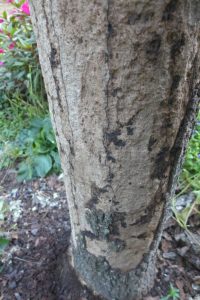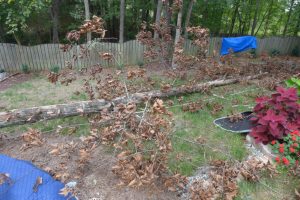The oak was dead. 45 feet tall, 11 inches wide, leaves and bark all. Before Hurricane Matthew came through NC, I received a call to take this dead oak down in its fenced-in yard. Get it down under control, not under the heavy winds and rain of Matthew.

The homeowner advised there was one corner of the yard where the tree would fit, correctly so. In addition, the yard was well gardened with flower beds and plenty of hardscape – overall a beautiful yard you don’t want to damage. Moving blankets protected the pavers, a tarp the fence.

Why was the tree dead? Lightning was one possibility as the tree seemed to suddenly die. Lightning strikes can go without visual damage for seasons, too, so when it happened was hard to say. When I dug around the base of the oak to inspect the root collar, I dug over 8 inches and still didn’t reach the roots. Suffocation may have killed this oak as tree roots need oxygen too. Construction is often the cause even though years pass before the tree suddenly dies.


I sounded the tree with a 3 lb. hammer. Dry but solid. The outer phloem was completely dead, the leaves totally dry.
I used a rope to control the oak with a rope puller, then the usual notch, back-cut, and wedges. Look at the stump and you can see two patterns on the back-cut, the obscured portion with a dull chain, and the clear portion a sharp one.

The tree landed right on the spot. The homeowner chose “downing” only, so I cut up and stacked the oak into a few portions and cleaned up. No damage to the hardscape and minimal damage to the tender salvias and torenias around the base of tree. The wood was dead heavy, each section 100 pounds easy. Only the top fifteen feet were completely rotten.







